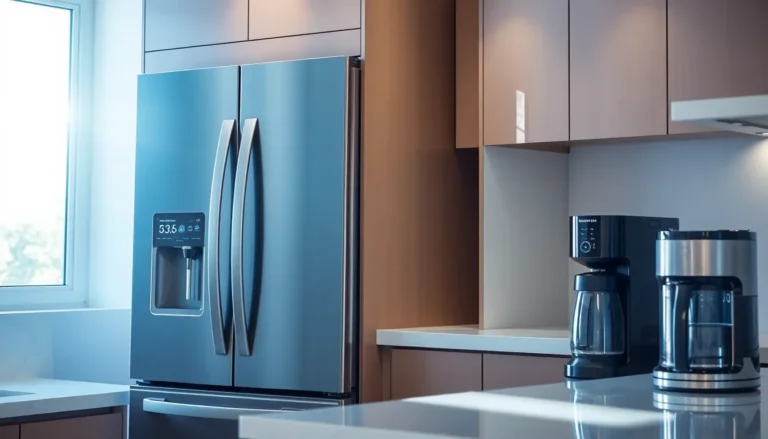Imagine a world where your fridge knows when you’re out of milk and your thermostat adjusts to your perfect temperature before you even step through the door. Welcome to the Internet of Things (IoT), where everyday objects become smart allies in the quest for convenience. It’s not just a techy dream; it’s a reality that’s transforming homes, businesses, and lives.
Table of Contents
ToggleOverview of the Advantages of the Internet of Things
Increased connectivity defines the Internet of Things (IoT), allowing devices to communicate and share data seamlessly. Enhanced efficiency results from automated processes, reducing the need for manual intervention. Cost savings emerge through optimized energy usage, as smart devices adjust their operations based on real-time data.
Improved safety and security are significant advantages of IoT; smart systems monitor environments for anomalies, alerting users promptly. Better decision-making arises from data analytics generated by connected devices, providing insights that inform strategic choices. Enhanced user experience leads to customized interactions, as smart technologies adapt to individual preferences.
Real-time monitoring enables users to track and manage resources effectively. For example, smart thermostats adjust heating or cooling based on occupancy, promoting comfort while minimizing energy waste. Predictive maintenance decreases downtime in industrial applications, as connected machines signal when service is needed.
Scalability in IoT systems allows organizations to expand their networks without significant challenges. Businesses benefit from increased productivity, leading to higher output with fewer resources. Collaboration across diverse sectors emerges from integrating IoT solutions, fostering innovation and driving economic growth.
Consumer behavior is affected by the convenience and personalization IoT offers, creating smarter homes that enhance lifestyle quality. The advantages of the Internet of Things are transforming various industries, reinforcing its significance in contemporary life.
Enhanced Connectivity

Enhanced connectivity serves as a cornerstone of the Internet of Things, elevating how devices interact and share information.
Seamless Communication Between Devices
Devices communicate effortlessly with one another. Smart appliances, such as thermostats or lighting systems, link through secure networks. This coordination allows users to manage multiple elements from a single interface. When smartphones control home security systems, peace of mind increases as monitoring becomes more accessible. Systems work together without human intervention, leading to smoother operations. The integration of various devices fosters a more cohesive living environment.
Real-Time Data Sharing
Real-time data sharing enables devices to transmit updates continuously. Sensors in smart homes, for example, provide immediate information regarding temperature or energy usage. This up-to-date communication empowers users to make informed decisions quickly. Businesses leverage real-time analytics for inventory management, improving their responsiveness. Efficient systems reduce response times significantly, enhancing overall productivity. Through constant data exchange, the Internet of Things ensures users remain informed and prepared.
Improved Efficiency
Improved efficiency stands as a major advantage of the Internet of Things (IoT). Enhanced automation and effective energy consumption streamline various processes across industries.
Automation of Processes
Automation transforms routine tasks into streamlined processes. Businesses utilize IoT devices to automate inventory management, resulting in optimal stock levels and reduced manual effort. Smart sensors control production lines, leading to fewer errors and increased throughput. Employees spend less time on repetitive tasks, leaving more room for strategic initiatives. With real-time updates, systems can adjust quickly to changes, maintaining operational efficiency. Enhanced productivity emerges from interconnected devices that coordinate schedules, task management, and communications.
Energy Savings
Energy savings contribute significantly to overall operational efficiency. Smart thermostats adjust temperatures in response to real-time data, minimizing unnecessary energy consumption. Efficient lighting systems activate only when needed, reducing overall electricity costs. Businesses see a notable decrease in utility bills when IoT applications optimize energy usage across facilities. Data analytics provides insights into consumption trends, allowing for targeted energy-efficient strategies. Organizations actively lower their carbon footprint while retaining higher levels of comfort and functionality.
Data-Driven Insights
Data-driven insights emerge as a fundamental advantage of the Internet of Things, enabling smarter and more informed decisions. Businesses leverage real-time data to better understand customer preferences and operational efficiencies.
Enhanced Decision-Making
Enhanced decision-making relies on the seamless flow of data from connected devices. Organizations analyze real-time information to respond quickly to market changes. Decision-makers utilize insights from IoT systems to identify trends and patterns. Accurate data enhances the ability to forecast demand and optimize processes effectively, leading to improved resource allocation. Each department, from marketing to supply chain, benefits from data analysis, resulting in a more agile organization.
Predictive Analytics
Predictive analytics transforms how companies approach future planning. IoT devices collect vast amounts of data, which analysts use to predict trends and potential issues. Businesses apply these insights to prevent equipment failures and optimize maintenance schedules. By anticipating customer needs, organizations enhance service delivery and increase satisfaction. Data sets provide valuable foresight, allowing businesses to allocate resources more efficiently and prevent costly disruptions.
Increased Convenience
The Internet of Things (IoT) significantly boosts convenience in daily life. Smart devices transform ordinary homes into personalized living spaces that cater to individual preferences.
Smart Homes and Personalization
Smart homes enhance comfort through personalized settings. Devices like smart thermostats learn user habits, adjusting temperatures automatically for optimal comfort. Lighting systems offer tailored illumination, adapting to moods or activities. Personalized notifications keep users informed about energy usage and security status. The seamless integration of various smart devices fosters an environment where individuals maintain control over their surroundings efficiently.
Remote Monitoring and Control
Remote monitoring elevates convenience by enabling users to manage devices from any location. Smart cameras and sensors provide real-time alerts for unusual activity, enhancing security measures. Homeowners can access their systems through mobile apps, adjusting settings as needed while away. This flexibility leads to peace of mind, as individuals oversee essential functions, including lighting and thermostats, from a distance. Remote control capabilities allow for timely adjustments, ensuring optimal efficiency and comfort consistently.
The Internet of Things is revolutionizing the way individuals and businesses interact with their environments. By fostering seamless connectivity and real-time data sharing, IoT enhances efficiency and convenience in everyday life. Smart devices not only streamline operations but also provide valuable insights that empower users to make informed decisions.
As IoT continues to expand, its ability to create personalized experiences and optimize resource management will only grow stronger. This technological transformation is set to redefine industries and daily routines, showcasing the undeniable advantages of embracing the Internet of Things.






